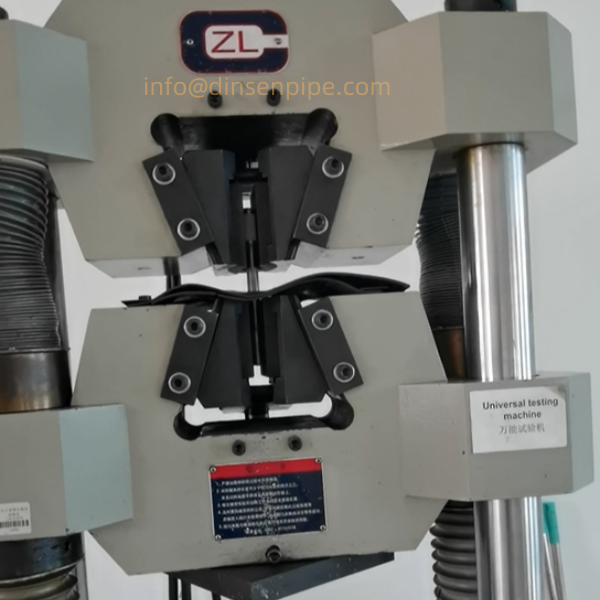-

What is the ISO standard for ductile iron pipes?
ISO2531 is the core document of the International Organization for Standardization’s standard for ductile iron pipes, fittings, accessories, and joints. First published in the 1970s, this standard has undergone numerous revisions and updates. The latest version provides comprehensive requir...Read more -

Ductile Iron Pipe Brazil Standards Guide: NBR7675 & NBR15420:2022 Explained
The Brazil standard NBR7675 is the fundamental specification for ductile iron pipes (DI pipes) in water applications, covering: Chemical composition requirements for pipe materials (carbon, silicon, manganese, phosphorus, sulfur, etc.) Mechanical performance indicators (tensile strength ≥420 M...Read more -

DINSEN Ductile Iron Pipes: EN545 Type Testing for Guaranteed Quality
As a high-end piping brand solution provider, DINSEN understands that every pipe carries the weight of safety, durability, and trust. To this end, we have built a “triple quality protection” system from materials to finished products—namely, rigorous factory inspection, scientific sam...Read more -

What is the Difference between K9 and K7 DI Pipes?
The choice between K7 and K9 essentially boils down to a decision about “pressure requirements” and “standard grade.” K9, with its standardized thick-walled design and stringent international standards, is a more reliable choice for high-pressure environments and projects ...Read more -

Explore DINSEN’s Full Range of Infrastructure Piping System Solutions
From the clean tap water we drink every day to the smooth discharge of rainwater and sewage, and the fire protection systems that safeguard lives and property, every pipe and every connector is a cornerstone of urban safety and vitality. As a reliable partner in the infrastructure sector, DINSEN ...Read more -

Quality-Ensured Ductile Iron Pipe: EN545 Cement Lining for Superior Performance
In water supply systems, water conservancy projects, and municipal pipe networks, ductile iron pipes are the preferred material due to their high strength, high toughness, and excellent corrosion resistance. The internal corrosion protection and water quality safety of these pipes heavily rely on...Read more -

DINSEN Ductile Iron Pipes: Superior Protection – A Detailed Explanation of the Dual-Protective Coating System
In harsh underground environments, the durability and corrosion resistance of pipelines directly determine the lifespan and safety of the entire water supply system. DINSEN ductile iron pipes are renowned not only for their high-strength ductile iron body but also for their rigorous and scientifi...Read more -

In-depth Analysis of Water Pressure Testing Standards for Ductile Iron Pipes and Fittings
Beneath the city’s surface, a network of ductile iron pipes forms a vital lifeline, tirelessly supplying water day and night. How can we ensure that every pipe leaving the factory is rock-solid and leak-proof? The answer lies in the extremely rigorous water pressure testing process. Today, ...Read more -

EN545 Brinell Hardness Requirements and Test Methods
At DINSEN, our pursuit of quality begins with our relentless pursuit of the highest standards in materials. Hardness, a key indicator of the durability and reliability of ductile iron pipes, is something we adhere to with an unwavering commitment far exceeding the standard. Our hardness test is a...Read more -

DINSEN DI Pipe: The Superior Tensile Strength Solution for Modern Pipeline Networks
In the wave of urban development, water conservancy projects, and industrial construction, the safety and durability of pipeline systems have always been a focus of industry attention. Ductile iron pipes, with their superior tensile strength and comprehensive performance, have become the preferre...Read more -

Tensile Testing of Ductile Iron Castings: Sampling and Test Bar Preparation per EN 545
According to EN545 standard, ductile iron castings must adhere to strict sampling and test bar preparation specifications during tensile testing to ensure accurate assessment of material properties. The following is an overview of key requirements: I. Sampling Requirements The thickness of the s...Read more -

Key Specs of EN545 Ductile Iron Pipe: Length Measurement and Straightness
1. Measurement of ductile iron pipe length under EN545 standard Dimensional accuracy of ductile iron pipes and fittings is fundamental to ensuring tight pipe joints and convenient installation. The EN545 standard establishes scientific and rigorous specifications for the length measurement of duc...Read more
© Copyright - 2010-2024 : All Rights Reserved by Dinsen Featured Products - Hot Tags - Sitemap.xml - AMP Mobile
Dinsen aims to learn from world famous enterprise like Saint Gobain to become a responsible, trusty company in China to keep improving the human being life!









